
Or, to put it in more practical terms, if I promise to show you more properly-formatted pages while I’m at it, will you forgive my devoting tonight’s post to a foray into a notorious editorial pet peeve? What about if I talk about several?
It’s not as though there aren’t dozens from which to choose: as I may have horrified you with depressed you into a stupor by bringing up mentioned in passing last time, those of us fortunate enough to read for a living are expected — and often rigorously trained — to notice patterns in writing. How often a manuscript uses the word blanched, for instance, or describes anything as being mauve.
Not that there’s anything inherently wrong with either word choice, mind you, when used sparingly. Surely I will astonish no one, however, if I suggest that your garden-variety reader might prefer not to see characters blanching at the sight of mauve objects on every other page. Adult readers, if you must know, tend to become bored by word and phrase repetition every bit as quickly as they lose interest in a slow-moving plot, dull explanation, or unsympathetic protagonist’s plight. In order to spare the reading public that pain, editors strive to catch not only larger narrative issues, but also redundancies, whether they be of concept, image, or phrase.
And, bless our hearts, we are seldom shy about pointing them out, sometimes as early as the second or third time an author uses a pet word or action. “For heaven’s sake, Mavis,” we have been known to scrawl in manuscript margins, “Jeremy has blanched, went pale, and felt the blood drain from his face already in a 4-page scene — need he also waste the reader’s time noticing his ashen face in the nearest mirror? What’s a mirror doing in the middle of a forest, anyway? And while we’re talking plausibility,” Mavis would be expected to turn the page over here, to read the editorial scribblings on the back of the page, “are you planning at some point to provide the reader with some explanation for all of the mauve leaves on the purple trees? Is the water supply in this forest somehow tainted? Are the trees subject to some sort of lavender mite infestation? Or have you perhaps forgotten that the trees on the other side of the world you’re describing were also on the mauve side?”
Given so much provocation on the page, it is perhaps not altogether surprising that one of the great long-term liabilities of reading for a living — or one of the great advantages, depending upon how one chooses to look at it — is that over time, the dedicated pro becomes decreasingly able to read anything without scrawling corrections in the margins. I’m not merely talking about manuscripts, synopses, and queries here, mind you, but all typed words on a page. The New York Times, for instance, once the standard of American prose, now seldom passes under my long-lashed eyes without picking up some entirely justified marginalia. Nor do magazines go unscathed: I’m looking at you, Radcliffe Quarterly.
Heck, I routinely take a corrective pen to menus, fliers, and wedding programs. One recent November, I had to be restrained bodily from correcting a grievous misprint on my ballot for a county election; the proper spelling would have confused the counting machine, I’m told.
But would that not have been preferable to asking the citizenry to select a superior court joge? Possibly to serve in mauve robes?
While in some walks of life, this level of habitual scrutiny might prove somewhat problematic, for professional readers like agents, editors, and contest judges (or, in this county, joges), it’s a positive boon. So what if in some benighted professions, it is neither expected nor considered particularly sane to look one’s coworker in the eye and say, “I like the content of you’re saying, Ziggy, but the fact that you uttered the word exciting fourteen times over the course of a six-minute speech, insisted upon using impact as a verb, and failed to define a good third of your basic terms detracted from your presentation’s effectiveness,” without finding oneself cordially disinvited from all future meetings? Someone has to defend the language. And by gum, if that means rending our garments and wailing to the heavens, “You’ve used this metaphor twice in 137 pages! And phrased it almost identically each time, you…you?torturer,” well, we’re up to the task.
I see some of you blanching, doubtless at the thought of that manuscript you recently sent out to the agent of your dreams. Well might you turn pale, ashen-faced ones. If the same metaphor graced page 1 and page 241, a good editor would catch it. So is it really so much of a surprise that an even ordinarily conscientious agent — or, for that matter, Millicent, the agency screener — felt all of the blood draining from her face when that metaphor cropped up on pp. 1 and 5? Or — sacre bleu! — twice on page 1?
Half the good professional readers I know would not only have become impatient at any of these levels of metaphor repetition — they would have leapt to the conclusion that the writer was repeating himself so much on purpose. Clearly, this is an authorial plot to get away with lazy writing. As opposed to, say, an authorial failure to recognize that his pet phrase of today was also the pet phrase of three months, eight days, and sixteen hours ago.
How could you? You know how much such things upset Millicent.
Actually, you probably didn’t, at least when you first began to write. Until a writer has enjoyed the incomparable pleasure of having her work dissected disemboweled subjected to professional critique, she tends not to have any idea of how closely an agent or editor is likely to read, much less a Millicent. As we discussed yesterday, the overwhelming majority of first-time queriers and submitters fully expect their pages to be read with, if not a completely charitable eye, than at least a willingness to look past little things like conceptual redundancy and an over-reliance upon a select group of particularly nice words. It’s the overall writing that counts, right?
Can you hear Millicent giggling? From a professional reader’s perspective, the very notion that repetitious word choice, recycled notions, or even frequent typos would not be considered part of the authorial voice being offered in a submission is pretty funny. A screener can judge writing only by what’s on the manuscript page, after all. And is Millicent really so wrong to believe that a manuscript in which every inanimate object is apparently mauve-tinted might be indicative of a slight compositional problem?
Then, too, most writers radically underestimate how good a well-trained professional reader’s memory for text will be. Remember, Millicent is usually in training to become either an agent, who would be expected to read a client’s fourth revision and be able to tell how it had changed from the three previous drafts, or an editor, who might conceivably find himself telling a bestselling author, “By jingo, Maurice, I’m not going to let you do it! You used precisely that simile in Book I of this five-part series; you can’t reuse it in Book V!”
Oh, you think I’m exaggerating, do you? Earlier today, I found my text-addled mind drifting back to a novel-cum-memoir I had read, I kid you not, in junior high school. And not merely because Memorial Day is a natural time to consider the noble calling of memoir-writing. A pivotal scene in that book, I felt, would provide such a glorious illustration of a common narrative mistake — both in manuscripts and in queries, as it happens — that I just had to drop our series-in-progress and track down the book.
Yes, yes, I know: sometimes, even other editors are surprised at how well I remember text. A few years ago, when my own memoir was lumbering its way through the publication process, my acquiring editor scrawled in my margins, “Oh, yeah, right — you remember a biography of the Wright Brothers that you read in the third grade? Prove it!” I was able not only to give him a chapter breakdown of the book, but tell him the publisher and correctly identify the typeface.
That’s how little girls with braids grow up to be editors, in case you had been wondering. If anyone wants to talk about the estimable Katharine Wright Haskell, apparently the only member of the Wright family bright enough to realize that heaving the first airplane off the ground might be of more significance if somebody bothered to alert the media, I’m still prepared and raring to go.
So I had good reason to believe that my recollection of a fictionalized memoir ostensibly written by a childhood friend of Joan of Arc was reasonably accurate. A lighthearted burrow through the roughly two thousand volumes I carted up from California after my mother moved from my childhood home, so she would have to tote only the remaining eight thousand with her (long story), and voil?! The very pages I had in mind.
Care to guess whether I’d remembered the font correctly?
I’m delighted that I did, as this excerpt provides excellent examples of the kind of narrative missteps that Millicent thinks so many of you do on purpose, just to annoy her. For starters, it exhibits the all-too-common narrative trick of echoing the verbal habit of using and as a substitute for a period in first-person narration, in a misguided attempt to make the narrative voice sound more like everyday speech. It can work, but let’s face it, quite a bit of everyday speech is so repetitious that it would be stultifying if transcribed directly to the printed page.
It also, you will be pleased to hear, beautifully demonstrates another classic memoir bugbear: telling an anecdote on the page as one might do out loud at a cocktail party, with practically every sentence a summary statement. (Hey, there’s a reason that show, don’t tell is such a pervasive piece of editorial feedback.) And, most common of all in both memoir and fictional first-person narratives, the pages in question much character development for anyone but the protagonist.
All sounds pretty terrible, doesn’t it? Actually, the scene isn’t badly written; the aforementioned garden-variety reader might not even have noticed some of these problems. Nor, unfortunately, would most aspiring writers prior to submission, for the exceedingly simple reason that far too few of them ever actually sit down and read their work beginning to end, as any other reader would. The writer already knows what’s on the page, right?
Or does he? My guess is that in this instance, the writer had very little idea that what he was slapping on the page was even vaguely problematic.
But you shall judge for yourself. To render the parallels to what Millicent sees on a daily basis more obvious, as well as to continue our exercises in learning to know properly-formatted manuscript pages when we see ‘em, I’m presenting that memorable scene here in standard format. As always, my blogging program is for some reasons best known to itself a trifle hostile to page shots, so if you are having trouble reading individual words, try holding down the COMMAND key and pressing + to enlarge the images.



Come on, admit it — while you might have excused all of those ands if you had heard this tale told out loud, they’re a trifle eye-distracting on the page, are they not? Ditto with the word repetition — could this author possibly have crammed any more uses of to be, to get, or to see into these three pages? And don’t even get me started on concept repetition.
I sense those of you committed to the noble path of writing memoir — or writing reality-based fiction — shifting uncomfortably in your chairs. “But Anne,” you protest, averting your eyes, “this isn’t the powerful negative example you led us to expect. I get what you mean about the sheer volume of ands, but other than that, there’s nothing wrong with the narrative voice here, given that this is a memoir. Isn’t part of the point of any memoir that the voice does sound like someone might speak? Is that not, in fact, one of the charms of first-person narration in general?”
Well, yes, but just as an event’s having actually occurred in real life (and it’s true, too!) does not necessarily mean that it will inevitably strike the reader as plausible on the page, first-person narration’s reading like everyday speech does not guarantee readability. In print, narrative chattiness may work against the reader’s enjoyment, because chatty people, like the rest of us, reuse words and phrases so darned much. Even talented verbal anecdotalists seldom embellish their tales with the level of detail that the most threadbare of written accounts would require. And funny out loud, let’s face it, does not always equal funny on the page.
Which is to say: as delightful as our example above might have been tumbling out of the mouth of a gifted storyteller, as a story on a page, it’s lacking quite a few elements. A sense of place, for one — is there a reason, the reader must wonder, not to give us some sense of what either the woods or the village were like? If both are left so completely to the reader’s imagination, is there not some danger that a Millicent fresh from polishing off the manuscript before this one might automatically assume that those trees were mauve, and those villages occupied by the wan?
Oh, you thought I’d dropped that running joke? In a blog, I can get away with going back to that same well this often. How many times, though, do you think I could revisit the joke in a book before the reader got bored? Or Millicent became irritated?
While you’re pondering those troubling questions, let’s return to our example. How else does it fall short?
Well, as so often happens in memoir, we’re just told that the action is happening here or there, rather than shown what those places were like. And lest anyone be tempted to shout out that old writing truism, “But it’s stylish to leave something to the reader’s imagination!, let me ask you: based upon the pages above, could you tell me where these people are with enough specificity that a reader would be able to feel like she’s there?
“But that’s not fair!” I would not blame you for shouting indignantly. “It’s the writer’s job to establish a sense of place, not the reader’s job to guess.”
Precisely what Millicent would say. She would object, and rightly, to this scene’s providing her with too little description to enable her to picture Joan and her young friends operating within an environment. Nor are those friends fleshed out much, either in character or physical trait.
Heck, poor Millie doesn’t even get to see the frightening Benoist: instead, the memoirist merely asserts repeatedly that he and Joan were getting closer, without showing us what that have looked like to a bystander. Like, say, the narrator of the scene.
Speaking of the narrator, were you able to glean much of a sense of who he is as a person? How about what his relationship is to Joan? Are you even sure of their respective ages? Any idea what year it is? Heck, if you did not already know that the girl would grow up to be the patron saint of France — actually, one of four, but Joan of Arc is certainly the best known in this country — would anything but the children’s names tip you off about what part of the world these characters inhabit?
While I’m asking so many rhetorical questions in a row — another occupational hazard, I’m afraid; margins absorb them like a sponge does water — let me ask a more fundamental one: did you notice that although this excerpt is apparently about how the village’s children reacted to Joan, there’s practically no character development for her at all?
That’s at least marginally problematic, in a book entitled — wait for it — PERSONAL RECOLLECTIONS OF JOAN OF ARC. What, we are left to wonder, does she look like? Why doesn’t she stand up to her playmates (beyond, of course, the justification of being “so girlish and shrinking in all ways”) or, failing that, why doesn’t she simply walk away from the nasty little beasts?
And don’t stand there telling me that the narrator had no choice in the matter, because that’s how it really happened. Yes, a memoir or fact-based fictional story should be true, but it also has to be both interesting in the page and plausible. Reality, unfortunately, is not always plausible; it’s the writer’s job to make it so on the page.
Which begs another editorial question: why can’t a kid brave enough to face down the village madman’s axe (or ax, depending upon where it falls in this passage; the error is in the book in front of me), a rather interesting thing for a person to do, come up with more revealing answers to questions than a simple yes? This is another notorious editorial pet peeve: almost without exception, the least character-revealing way for anyone to answer a yes-or-no question is with — again, wait for it — a simple yes or no.
Are some of you writers of the real blanching now? “But Anne,” you gasp, clutching your ashen cheeks so heavily drained of blood, “people actually do answer questions that way! And isn’t the point of written dialogue to reproduce the feel of actual speech?”
Well, that’s one of the points of dialogue. Another is not to bore the reader to death, isn’t it? And, if at all possible, it should be entertaining.
Just holding a tape recorder up to nature tends not to be the surest means of hitting any of those excellent goals. Why? Chant it with me now: most everyday speech is repetitious.
I can stand here and keep saying that as long as necessary, people. Again and again and again.
As we may see in the scene above, a character that keeps saying nothing but “Yes” isn’t exactly thrilling the reader with deep insight into her thought processes. Or even into the scene itself: little Joan is not, after all, a hostile witness in a murder trial, but a child talking with her playmates. Wouldn’t it ultimately be more realistic, then, if she sounded like the latter?
Speaking of realism, would it be too much to ask the narrator to explain why the villagers left an axe lying anywhere near the madman’s cage in the first place? Might not the locals’ efforts have been more productively expended making sure he can’t get out than chopping off his fingers?
And yes, in response to what half of you just thought: this is precisely the kind of thing an editor would have gripped her pen angrily and inked into the margins of a manuscript. Not because she’s mean, but because she’s trying to help the writer give the reader a more enjoyable reader experience.
That’s a noble calling, too, you know. But in the unlikely event that some writer out there might care less about the moral beauty of Millicent and her ilk’s devotion to textual excellence than how to worm his way past it in order improve his submission’s chances of getting picked up by an agency, let me hasten to add that the sooner a writer learns to read his own manuscript the way a professional reader would, the easier he will find self-editing. Not to mention being able to catch the Millicent-irritants that can prompt a screener or contest judge to stop reading.
In the interest of helping you fine people develop that ability, let me ask you another question about today’s example: if you had previously known absolutely nothing about what the what the real-life Jeanne d’Arc achieved, wouldn’t you find it at least a trifle too pat that her playmates choose to picture her doing more or less what she grew up to do — and to laugh at her about it? If the girl had suggested this role herself, it might merely have been not-particularly-subtle foreshadowing, but honestly, can you think of any reason to include this at all except to make the reader feel cleverer than St. Joan’s playmates?
Millicent wouldn’t be able to think of one. Neither would most professional readers; it’s our job to deplore this sort of narrative ham-handedness.
“Just how ill-informed would a reader have to be not to find that first bit clumsy?” we mutter into our much-beloved coffee mugs. “Isn’t it safe to assume that anyone who would pick up a book about Joan of Arc would know that she lead an army and was burned at the stake, even if that reader knew nothing else about her? And if your garden-variety reader knows that much, isn’t it an insult to his intelligence to drop a giant sign reading Hey, dummy, this is foreshadowing?”
Was that mighty gust of wind that just whipped the cosmos the sound of half of the memoirists out there huffing with annoyance, or was it merely the first-person novelists sighing gustily? “But Anne,” both groups think loudly in unison, rather like the remarkably collective-minded children in the anecdote above, “this is how I was taught to write first-person narration. It’s supposed to sound exactly like a real person’s speech. So why shouldn’t St. Joan’s unnamed childhood buddy sound like anybody else telling anecdotes out loud?”
A couple of reasons, actually. Yes, good first-person narration takes into account the narrator’s individual speech patterns; no dialogue should sound like just anybody. Which is precisely the problem with all of those yeses, right? All by themselves, yes and no are generally presumed to mean the same thing, regardless of who is saying them. So, like polite spoken clich?s of the “Excuse me” and “I’m so sorry for your loss” ilk, they are too generic to convey personalized content.
Strong dialogue also typically reflects the narrator’s social status and education, personal prejudices, and what s/he could conceivably know in the situation at hand. And then there are those pesky individual quirks and, yes, the century in which s/he lived.
So I ask you, first-person writers: just how does the narrative voice in this passage indicate that this particular anecdote took place not too long after the Battle of Agincourt in 1415? As opposed to, say, the 1890s, when this account was first published?
And if you were tempted even for a nanosecond to mutter in response, “Well, if the 1980s is when readers would have been seeing this dialogue, sounding like that just would have seemed normal,” let me ask a follow-up question: if this scene were narrated in the voice of a pre-teen texting this to a friend today, would that make this scene ring truer to today’s readers? Or would it merely read as though the writer either hadn’t thought much about how Joan and her friends might have communicated with one another — or was presuming that today’s readers were not capable of following any type of dialogue than their own?
Those of us who read for a living have a term for that kind of assumption: insulting the reader’s intelligence. We often find ourselves scrawling it in margins.
How often, you ask, your faces a mask of pallid horror? Well, operating on the assumption that internal monologues have both always sounded pretty much like modern speech and don’t vary much from individual to individual is as common a mistake in first-person narratives as having all teenage characters sigh and roll their eyes is in YA submissions. Yes, some people do think and talk that way, but must everybody? Should Helen of Troy formulate her innermost thoughts in the same way as, say, Eleanor Roosevelt, Louisa May Alcott, or Confucius?
There’s a dinner party, eh? I’ll bring the stuffed grape leaves.
Doesn’t it make for more interesting narration if your narrator’s speech bears at least some marks of time? And if she has some individual quirks of thought and expression?
Besides, if we are going to be true to the rules of first-person narration, shouldn’t we be objecting to how often our narrator here professes to read the other children’s minds — although, notably, not Joan’s? I don’t know about you, but I find that most of the time, my thoughts are located in my own head, not floating somewhere in the middle of a group of bystanders. Millicent, too, tends to regard her own thoughts as separate from other people’s. The inevitable consequence: characters who think together tend to annoy her, unless their shared brains crop up within science fiction or fantasy context, where they can be plausible.
That cast a different light upon the narrative choice here, doesn’t it? As an editor might well scrawl in the margin, are we supposed to believe that our narrator in this instance is a mind-reader, or that the local children were too simple-minded to be able to form individual opinions about what is going on in front of them? Is the narrator just not familiar enough with the individual characters to be able to guess how their thoughts might have differed, or, (turn page over here) since he’s of a different social class than they are — not abundantly apparent in this scene, is it? — does his reporting that they all thought the same way a function of his views of their training in rational thinking? Or does it indicate the opposite, that he feels so close to them that he presumes that his beloved friends and he could only have thought and felt identically?
“Or, Mark,” the editor might conclude, “did you originally write this scene in the third person, with an omniscient narrator that could plausibly read everyone’s thoughts? If so, you can’t legitimately endow your first-person narrator with that ability. Pick a narrative perspective and stick to it!”
In fairness to Mark, as well as all of the blanching first-person narrative writers out there, plenty of writers actually were taught to write first-person narration this way — in short stories in their high school English classes. And with good faith, too: in short bursts, run-on sentences do indeed come across as ordinary speech-like. In the published examples of this type of narration that tend to turn up in class, it’s not all that unusual for the author’s voice and the first-person narrator’s voice to merge into colloquial harmony.
Or, to put it another way, Mark Twain tends to sound like Mark Twain, for instance, no matter whose perspective is dominating a particular story. That’s part of his branding as an author, right, his distinctive narrative voice and humorous worldview?
Admittedly, adopting a chatty voice makes quite a bit of sense for narrative voice in memoir. The reader is going to have to like how the narrator/protagonist talks about her life well enough to want to follow the story for a few hundred pages, after all; we might as well get friendly. Yet in practice, the primary danger of relying on the repetitive phrasing, clich?s, and percussive and use to achieve realistic-sounding narrative cadence is precisely that it will put off the reader because as the pages pass, it can become, at the risk of repeating myself, rather boring.
Think about it: even if a memoir were being told as a collection of verbal anecdotes, wouldn’t you rather listen to a storyteller with some individual flair for phrasing, instead of someone who just sounded like everyone else? No matter how inherently exciting a personal story is, a great telling can make it better reading. So can a narrative voice reflective of the time, place, and society in which that tale takes place.
But just try telling that to Mark Twain — who, as the sharper-eyed among you may already have noticed, wrote the scene above, in what he considered his best book. Although that retrospective assessment is a trifle hard to take seriously, in light of the fact that he published the book both under a pen name and in serial form. Actually, he took it to even one more remove: he wrote a preface under a nom de plume, presenting himself as the translator of a memoir written by one of young Joan’s contemporaries.
Why go to all that trouble? Because by all accounts, he felt that the poor sales of THE PRINCE AND THE PAUPER were largely attributable to his established audience’s expecting anything published under the name of Mark Twain to be a comedy. Good branding has its drawbacks for a creative artist.
Take that, purists who would like to believe that writing with an eye toward market concerns is a product of an increasingly cynical publishing industry over the last twenty or thirty years. Twain and his publisher worked out that tactic in the 1890s.
But I digress. As a reader, how well do you think his narrative choices worked here, either as fiction narration or as the memoir narration it originally professed to be? In your opinion as a writer, how do you feel about those slips into the first person plural — is the reader carried along with the we perspective as a narrative choice, as we were in Jeffrey Eugenides’ THE VIRGIN SUICIDES, or does it read like a perspective slip?
In today’s example, do you feel that the mostly distinctly modern narrative voice, coupled with the almost entirely uncritical view of Joan, was the best way to tell this tale? Reviewers in Twain’s time did not think so — they believed (and I must say I agreed with them back in junior high school) that a protagonist who never does anything wrong is a trifle on the dull side, as far as the reader is concerned. Twain’s Joan never sets a wee foot wrong; even in her earliest youth, he tells us, she raised her voice in anger only once, and even then it was to voice a patriotic thought.
A taciturnity unusual in a rabble-rouser, you must admit. Also an unusual characteristic for someone who challenged social norms enough for anyone to want to burn her at the stake: Twain’s narrator presents her as a quiet, universally beloved little girl. Butter, as folks used to say, would not melt in her mouth.
But is that how little girls with braids grow up to lead armies?
Twain evidently thought so. No matter how outside-the-box her observations or actions are shown to be (or, as we saw above, summarized to be), in this narrative, nothing she did or said from birth to the age of fourteen so much as ruffled the composure of the inhabitants of a querulous small village in wartime. Surprising, to say the least, in a young lady who by her own account had been engaging in frequent heart-to-heart chats with a couple of your more illustrious virgin martyrs since the age of twelve.
Perhaps the querulous small village where I spent my formative years was atypical, but I’m inclined to think that had I gone around snatching murder weapons from the clutches of local lunatics or holding confabs with deceased ancient Roman maidens, the locals might have had a thing or two to say about it. I’m also inclined to think that their observations would not have been entirely favorable, regardless of how winsome and girlish I might have been while disarming the maniac in question. It doesn’t strike me as the type of endeavor best undertaken in a party dress.
I’m not saying that Twain is necessarily factually incorrect about any of this; naturally, his best guess is as good as ours on a lot of these points. The little lady lived rather a long time ago, so the issue here is less historical accuracy than dramatic plausibility. Still, just because something really happened does not mean it will necessarily come across as plausible on the page; as agents like to say, it all depends on the writing.
As an editor, though, I think it was Uncle Mark’s job as a writer’s to make me believe his take on this. Presuming you agree with me — speak now or forever hold your peace — I ask you: was this narrative choice the best fit for the story he wanted to tell? And if not, should Millicent accept this manuscript?
Does the fact that a good third of you just began hyperventilating mean that it had not occurred to you that whether a story is not only well-written, but attacked from an appropriate narrative angle is a potential rejection trigger? It is, inevitably. Wouldn’t it have been nice if your last rejection letter had told you that, if Millicent or her boss thought that your first-person story would have worked better as a third-person narrative, or vice-versa?
Literary taste is, of course, to a very great extent individual, so only you can answer my question about Uncle Mark’s narrative choices to your own satisfaction. Am I correct in presuming, though, that you are at least a tiny bit curious about how an editor currently holding down the literary fort in the U.S. publishing world might respond to the choices he did make? Glad you asked. Let the scrawling begin!



What am I hoping you will take from this, you ask, eyes wide with horror and previously rosy cheeks drained of blood? Not merely that being a brilliant writer does not necessarily preclude turning out a clunker of a first draft from time to time — although that’s not a bad thing for aspiring writers to bear in mind. The popular conception of true literary talent’s consisting of letter-perfect creative phrasing dripping from one’s fingertips directly onto the page, with no further polishing necessary, each and every time, does not match up particularly well with reality. As any experienced editor could tell you, most of the books people regard as semi-miraculous productions of pure inspiration have actually been worked, reworked, and run past half a dozen critical readers.
And I mean critical readers. The kind who will remember what the author did in the same scene in each previous draft.
Remember that, please, the next time you’re struggling with a scene that just doesn’t seem to want to hit the page gracefully — or with much specificity. In moments like that, it can be very tempting to embrace the tack Twain did above, writing up the scene in summary form, with few vivid details, just to get the darned thing committed to paper as rapidly as humanly possible.
What makes me think that this was written quickly? Editorial instinct, mostly: I find it hard to believe that a humorist as gifted at reading out loud as I know Twain to have been would have killed the comedy — or bored the reader — with this much word repetition unless he was writing on a pretty tight deadline. Serialization tended to be submitted that way back then, you know, as Dickens would have been only too glad to tell you. Had Uncle Mark taken the time to revisit this scene and iron out its wrinkles, I don’t think there would have been quite so many references to eyes — and, frankly, I don’t think that he would have had his narrator faint at the climax of the scene. He was too good a storyteller.
But that choice certainly saved the author the trouble of having to figure out how the girl convinced the wild man to give up the axe, though, didn’t it? Trust me on this one: experienced editors — and Millicents — see this type of narrative shortcut often enough to recognize it for what it is.
So what should a savvy writer do when faced with this sort of first-draft dilemma? Go ahead, give in to temptation; there is value in getting a full scene on paper. Just make sure to set aside time later in the writing process to return to that scene and flesh it out.
Unless you would prefer to have your future editor bark at you, “This is lazy writing, Ambrose. Didn’t anybody ever tell you to show, don’t tell?”
Just in case nobody has yet snarled that in the general direction of your manuscript: show, don’t tell. Immerse your reader in sufficient details for her to be able to feel as though she is part of the scene, rather than leaving her to fill in the specifics for herself.
Oh, you don’t think that’s what Twain is doing here? Okay, rise from your chair, grab the nearest willing partner, and try to act out this interaction between young Joan and Benoist, based solely upon the choreography the narrator above chose to provide us:
She stood up and faced the man, and remained so. As we reached the wood that borders the grassy clearing and jumped into its shelter, two or three of us glanced back to see if Benoist was gaining on us, and this is what we saw — Joan standing, and the maniac gliding stealthily toward her with his axe lifted. The sight was sickening. We stood where we were, trembling and not able to move. I did not want to see murder done, and yet I could not take my eyes away. Now I saw Joan step forward to meet the man, though I believed my eyes must be deceiving me. Then I saw him stop. He threatened her with his ax, as if to warn her not to come further, but went steadily on, until she was right in front of him — right under his axe. Then she stopped, and seemed to begin to talk with him. It made me sick, yes, giddy, and everything swam around me, and I could not see anything for a time — whether long or brief I do not know. When this passed and I looked again, Joan was walking by the man’s side toward the village, holding him by his hand. The axe was in her other hand.
Not much practical guidance for the actors there, eh? Other than all of that seeing (a word most writers tend to overuse in early drafts, incidentally), the actual movements mentioned here are pretty routine: one party standing still, the other moving toward her. The mover threatens, but we are not told how. Admittedly, a lifted axe doesn’t have to move much to seem threatening, but did you notice how pretty much all of the sense of danger is conveyed via the narrator’s dread, rather than through showing the reader vivid, terrifying specifics? And how virtually all of that dread is summarized, rather than shown in any detail?
From an editorial perspective, that lack of specificity distances the reader from what should have been a thrilling scene: by leaving us to fill in the details, the narrator abdicates his proper role here. It’s his job to make us feel that we were there, or at least to show us the scene engagingly enough that we have that illusion.
Yes, he grounds us in his experience by telling us repeatedly that he is seeing this or that, and that these sights made him feel sick (and ultimately pass out). But great heavens, man, if you’re going to narrate a story like this, isn’t it your job to at least ask a bystander what happened, so you could share that information with the reader?
Don’t tell me that once you’ve seen one axe-wielding madman, you’ve seen ‘em all. As both a reader and an editor, I want to know what this particular madman looked, sounded, moved, smelled, and felt like. I want to know precisely what our heroine did that gave Benoist pause; I want to be shown how he crept up on her stealthily while apparently walking straight into her line of vision. And gosh darn it, I want to know how an axe of 1415 differed from one I might buy at the corner hardware store today.
Without those details, and phrased in fairly ordinary terms, this excerpt is indeed like everyday speech, in the negative sense, despite the inherently exciting subject matter. Substitute a memo-wielding boss for the axe-bearing madman, and this could have been an anecdote overheard in a coffee house after work, couldn’t it?
Please don’t limit your answer to a simple yes or no. I was hoping to learn something about you.
Distancing the reader from the action in this manner is an unfortunately common tactic in memoirs and first-person fictional narratives alike. Instead of showing the reader what happened through a fully realized scene, the narrator simply summarizes; rather than demonstrating relationship dynamics through dialogue or action, the narrator just sums up what was said. And by describing subsequent actions in the same words or in hackneyed terms (I believed my eyes must be deceiving me? Really, Mark?), the action may move forward, but the reader’s understanding of what’s going on does not.
Joan stood; Benoist glided. Then Joan stood while Benoist glided. Then she stopped — odd as the narrative had not shown her going forward. Then the narrator conveniently blacks out so we cannot see what is going on. Then the problem is solved. The end.
A bit mauve, isn’t it? Well might you turn pale.
Seldom is this the most interesting way to convey a story, in my experience. Like having characters answer yes-or-no questions with yes or no, as opposed to more detailed (and thus more character-revealing) responses, the summary route closes off story possibilities. And by definition, repeated phrasing adds nothing new to the scene.
Neither, incidentally, do all of those thens: logically, they are unnecessary. Why? Well, in a story in which events are being presented in chronological order, the occurrences in Sentence 1 are presumed to have happened before those in Sentence 2, which in turn came before what’s described in Sentence 3.
Thens, then, as we have seen them used in that last example, are logically redundant; most editors would advise you to reserve them for moments when what happens next is genuinely unexpected. Take a gander:
Joan stood; Benoist glided toward her with an axe. Then the Wright Brothers and their sister, Katherine, swooped through an opening in the forest canopy in a motorized glider to snatch the weapon away.
Admit it — you didn’t see that last twist coming, did you? As a reader, didn’t you get a kick out of that?
Remember, there’s more to telling a story than simply listing its events in the order they occurred. Racing from its beginning to its end may not be the best way to engage the reader. You want the journey to be both memorable and enjoyable, right? And if the narrative can manage either to surprise the reader with an unanticipated turn of events, delight her with astonishing imagery, or intrigue her with beautiful phrasing — ideally, all three — all the better.
Before I release you to ponder the challenges of expanding a first-person narrative from the anecdotal level into a completely inhabited scene, I want to talk about another common faux pas: the further distancing effect of the narrative’s reminding us repeatedly that the narrator is seeing, hearing, or observing this or that. Obviously — at least from a professional reader’s perspective — if an action or object is depicted in a first-person narrative, the narrator perceived it; otherwise, she could not legitimately bring it up, right?
So when Twain’s narrator tells us repeatedly that he saw Joan do this or Benoist do that, it’s logically redundant. Of course, he saw it: he was standing right there. Why bother to remind the reader of that self-evident fact? Or, to put it as a garment-rending professional reader might, does the author think the reader is too brain-dead to remember who the narrator is and that he is present?
Oh, you don’t want the pros to take every word you commit to the page that seriously? But it’s how they show their respect for your eventual readers!
And for your literary gifts. Again: if it’s on the page and the writer appears to possess even the slightest vestige of talent, Millicent is going to assume that you put it there on purpose. She’s also going to believe, with good reason, that if a writer has set up rules for how the story is to be told — in this case, from the point of view of a childhood friend of Joan’s, and only from his perspective — the narrative will follow those rules consistently.
This, too, trips up quite a lot of memoirists and other first-person narrator-wranglers. Once a narrative is committed to a single perspective, it cannot report anything outside of it without shattering the illusion of a limited point of view. Thus, when the narrator slips into the first person plural, informing us that we saw this or thought that, it’s jarring to the reader’s sensibilities.
And when, like Twain’s narrator, he professes to know what we all are thinking…well, let’s just say that maybe Joan isn’t the only one who needs to be worrying about going on trial for dabbling in the supernatural. Unless the narrative establishes some means by which a first-person narrator could possibly have reliable insight into other characters’ thoughts and feelings, he should really stick to his own.
If his thoughts and feelings are somehow different from every Tom, Dick, and Benoist who might be hanging around in the same place at the same time, great. If he can manage to express them in language evocative, memorable, and tailored to his individual worldview, though, even better. And if he can work in a little character development, perhaps through revealing dialogue, terrific.
Which is not a bad definition of memoir voice, if you think about it: a narrator with a strong personality and specific worldview recounting situations of significance to an overall dramatic story arc in language and from a perspective unique to the teller. If every sentence of your memoir — and, to bring this back to our series-in-progress, every sentence of your query’s book description — does not rise to that level, you might want to think about revising it.
Millicent will thank you. So will your readers.
So Mark, darling, as much as I admire your writing in general and short stories in particular, if I were your editor — oh, you thought that editors don’t live in the hope that this type of activity would be the first, best use of a time machine? — I would insist that you sat down and revised these three pages. Actually, I would do it because I admire your writing: your narrative voice, even in this rather serious book, is better than what we’re seeing here.
And that axe you keep telling us you’re seeing, narrator? Try to think of it as your editor, chopping away all of that phrasing and conceptual redundancy. Trust your reader’s intelligence a bit more, please.
Do bear in mind, too, that while reality itself can be convoluted and devoid of point, readers have a right to expect a book based upon real events to be a good story possessed of an identifiable story arc. It should be dramatically satisfying. And if the real-life version is not, believe me, Millicent isn’t going to be inclined to take that as an excuse.
No need to go pale about this. You can do it. But in order to pull it off successfully, you’re going to have to be able to read your work not only like a writer, but also like a reader.
Oh, it feels good to be delving back into craft. Would anyone mind if I continued to keep standard format illustration on the back burner for a bit and made narrative voice my topic of the week?
Actually, that’s a rhetorical question, come to think of it. Keep up the good work!



















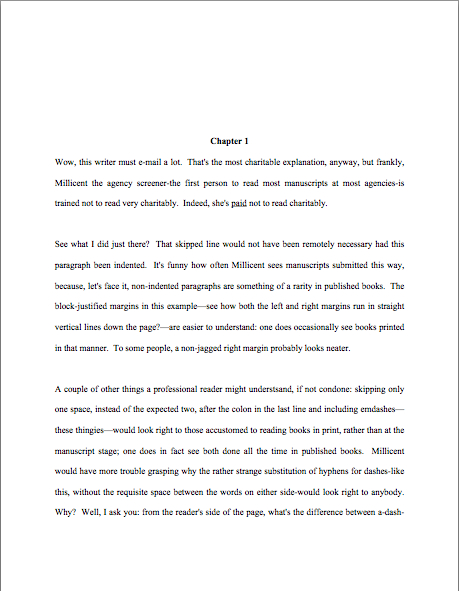














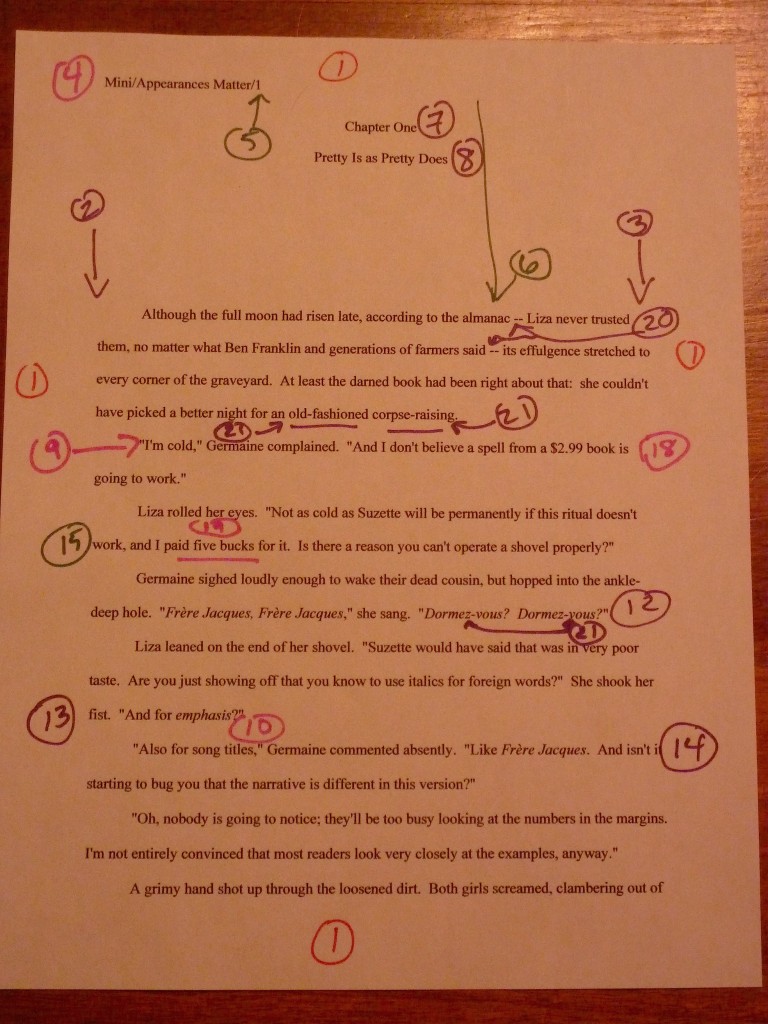

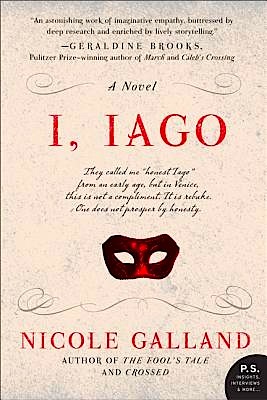









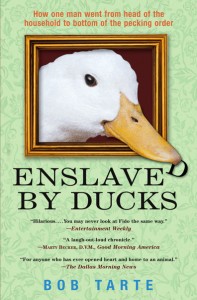 When Bob Tarte left the city of Grand Rapids, Michigan for the country, he was thinking peace and quiet. He’d write his music reviews in the solitude of his rural home on the outskirts of everything.
When Bob Tarte left the city of Grand Rapids, Michigan for the country, he was thinking peace and quiet. He’d write his music reviews in the solitude of his rural home on the outskirts of everything.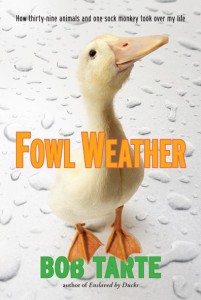 Bob Tarte’s second book, Fowl Weather, returns us to the Michigan house where pandemonium is the governing principle, and where 39 animals rule the roost. But as things seem to spiral out of control, as his parents age and his mother’s grasp on reality loosens as she battles Alzheimer’s disease, Bob unexpectedly finds support from the gaggle of animals around him. They provide, in their irrational fashion, models for how to live.
Bob Tarte’s second book, Fowl Weather, returns us to the Michigan house where pandemonium is the governing principle, and where 39 animals rule the roost. But as things seem to spiral out of control, as his parents age and his mother’s grasp on reality loosens as she battles Alzheimer’s disease, Bob unexpectedly finds support from the gaggle of animals around him. They provide, in their irrational fashion, models for how to live.